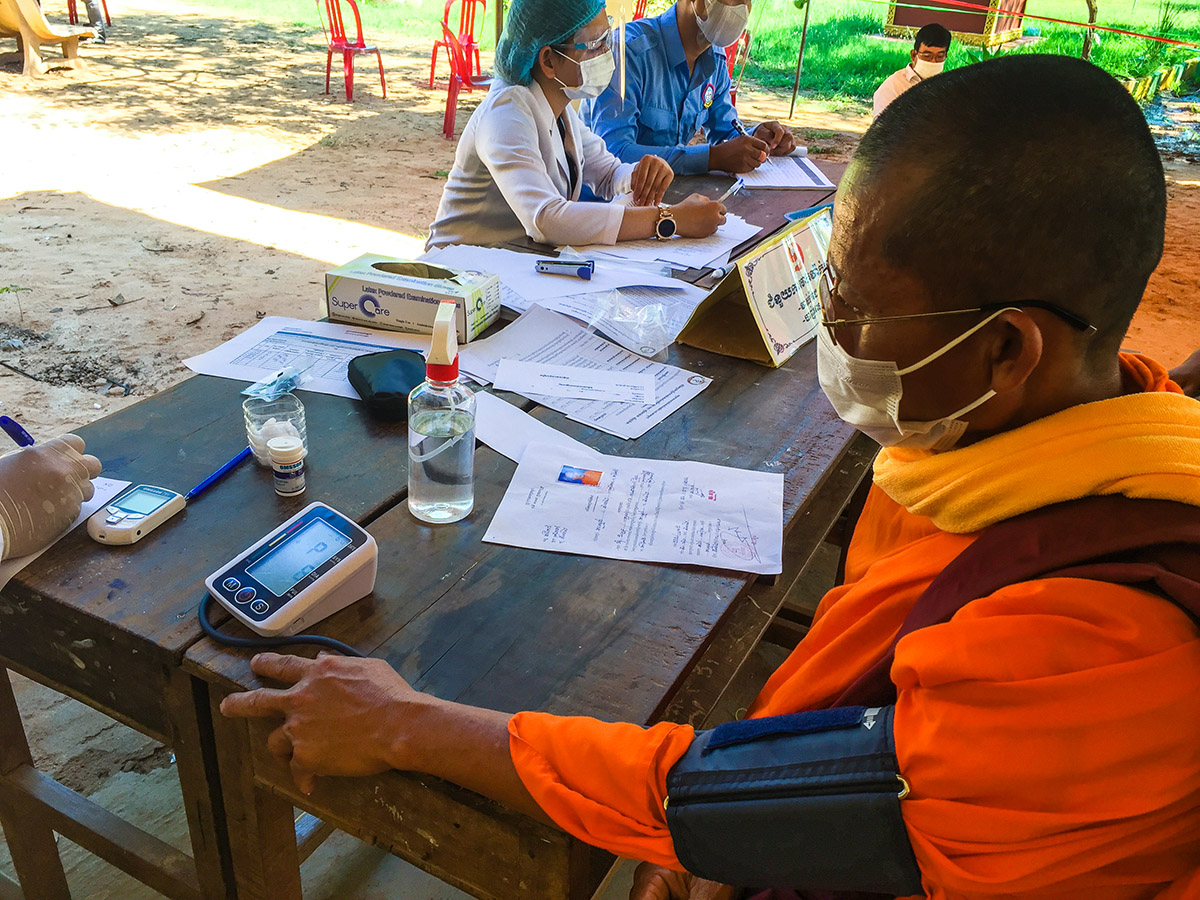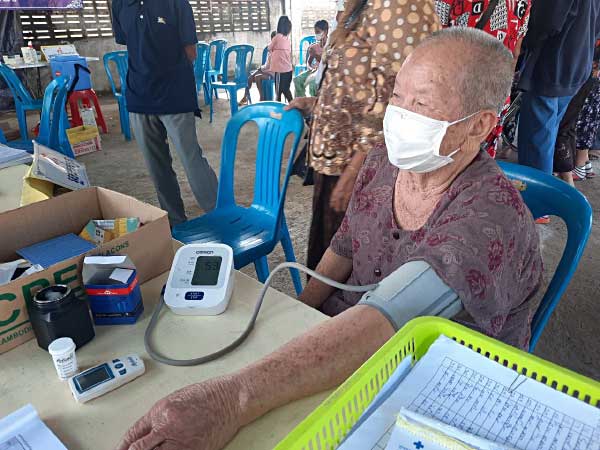“I am delighted to get blood pressure and glucose screening during the COVID vaccination. It’s a huge benefit as it’s a one-stop service that saves my time,” explains a 72-year-old patient at Ang Roka, Takeo province. Like many Cambodians, he was unaware of his risks prior to screening, but he tested “abnormal” for both blood pressure and glucose screening. He was thus counseled on lifestyle factors and referred to a nearby health facility for confirmatory diagnosis and treatment.
In Cambodia, like in most low- and middle-income countries, non-communicable diseases (NCDs), such as hypertension, cancer, and diabetes, are a growing public health challenge. Over the past three decades, Cambodia has made major improvements in health, with mortality rates falling by 60 percent since 1990.[1] Most of this progress was driven by improvements in communicable diseases and maternal and child healthcare. However, the burden of NCDs has only risen during this time. As of 2020, 23 percent of all premature deaths (below age 70) in Cambodia are attributable to NCDs.[2] Non-communicable diseases are estimated to cause US$1.5 billion of economic burden in Cambodia, equal to seven percent of the Gross Domestic Product, largely driven by indirect costs of premature death and reduced work capacity. In particular, the prevalence of diabetes in Cambodia is high, likely driven in part by the shared experience of the Khmer Rouge period for all Cambodians born before 1979 (as malnutrition in childhood increases the risk for diabetes later in life).[3]
Early stages of diabetes and hypertension are commonly asymptomatic, with hypertension sometimes referred to as the “silent killer,” leaving many unaware of any medical concerns. Recent data shows that over 14 percent of all Cambodians suffer from hypertension and nearly 10 percent have diabetes, including 20 percent of people between the ages of 60 and 69. Yet, there is still a large screening gap among Cambodian adults: of those surveyed in 2016, 43.1 percent had never been screened for blood pressure and 76.5 percent had never been screened for blood sugar. In one study in Cambodia’s Takeo province, over half of patients with diabetes already had kidney dysfunction, emphasizing the need for increased screening to diagnose disease earlier before progression.[4]
The United Nation’s Sustainable Development Goal 3.4 aims to reduce premature mortality by NCDs by one-third by 2030.[5] In Cambodia, the National Strategy Plan (NSP) for Prevention and Control of NCDs introduced in 2013 seeks to scale up screening, cost-effective care, and treatment. Targeting at-risk people over 40 with routine check-ups can provide early detection before diseases become unmanageable and untreatable.

A religious community member receives a blood pressure test during a visit for COVID-19 vaccination in Takeo province, July 2021
Leveraging COVID-19 vaccination sites for NCD screening
Early 2021, Cambodia began rolling out COVID-19 vaccinations to the general population. Within a few months, all Cambodian adults—many of whom would be unlikely to proactively visit a health facility for NCD screening—would come in contact with healthcare workers.
CHAI recognized this unprecedented opportunity and began working with Cambodia’s Preventable Medicine Department and the Provincial Health Department of Takeo and Kampong Chhnang Provinces, to design and implement a pilot program to provide adults over 40 with diabetes and hypertension screening while they received their COVID-19 vaccinations.
In June 2021, CHAI commenced its pilot support to 10 large vaccination sites, providing trainings for health workers and equipping them with necessary test kits and other essential supplies. CHAI also assisted with monitoring and evaluation of the program.
Of all adults over 40 being vaccinated for COVID at the pilot sites in July and August 2021, 25 percent opted in for diabetes screening and 26 percent for blood pressure screening; a total of 3592 individuals were screened. Of these, 37 percent had an abnormal result for blood pressure and 31 percent for diabetes. Over 1300 patients were referred to nearby health facilities for confirmatory diagnosis and treatment. All those tested also received counseling on risk factors, early warning signs of disease, and the importance of early screening and prevention.
A survey conducted in July 2021 showed the pilot’s high acceptability for the healthcare workers. Only 28 percent of the health care workers had previous experience screening patients for NCDs, yet 100 percent thought it was good to provide NCD screening during COVID vaccination. Average screening time was quick at less than two minutes for blood glucose and less than three minutes for blood pressure. When designing the operating model, particular care was given to ensure that the screenings did not slow down COVID vaccination rates, and both Takeo and Kampong Chhnang fully vaccinated their populations at the same rapid speed as other Cambodian provinces.
Patients particularly appreciated the service. 94 percent of the adults screened mentioned that they would pay more attention to their health in the future and will go for routine check-ups.

An elderly community member receives a blood pressure test during a visit for COVID-19 vaccination
Looking ahead: Strengthening NCD screening for integration with COVID-19 vaccine delivery booster shots at health center level
Cambodia’s COVID-19 mass vaccination campaign was largely conducted at hospitals and large sites, due to the urgency of the rollout. However, Cambodia’s Ministry of Health is currently planning for the likely need for annual booster shots for all Cambodians, which will be further decentralized at the local health center level.
This new and regular touchpoint with all populations at-risk of NCDs represents a golden opportunity to save lives through early screening, scaling the gains made in the integrated pilot. While until now a Cambodian patient presenting with no symptoms to a health facility may have been met with surprise, the COVID booster shot could become the cornerstone for an “annual health check-up” for all Cambodians.
However, most health centers in Cambodia do not currently have the capacity to diagnose and manage major NCDs due to lack of equipment, and shortage of essential medicines and supplies. Only in a few districts have health workers at the lowest levels been trained to diagnose, refer, and care for patients living with diabetes and/or hypertension.
Hence, CHAI, in close collaboration with the National Department of Preventative Medication and the World Health Organization (WHO) is currently supporting provincial health departments (PHDs) in the two focal provinces to implement integrated NCD screening when health facilities start to administer COVID-19 vaccine booster shots. This will involve training health workers to provide long-term care for patients diagnosed with hypertension and diabetes. CHAI has also supported training for community leaders and village health volunteers—essential touchpoints in communities— on the importance of NCD screening and prevention.
The Royal Government of Cambodia already has bold goals on both NCD control and COVID vaccination. Through documenting and broadly sharing the positive findings of this integrated pilot with relevant NCD and Primary Health Care (PHC) stakeholders, CHAI hopes to support the broader scale-up of this approach in additional provinces and in the medium term, nationwide.
This work is supported through funding from Bill & Melinda Gates Foundation. For more information, please contact Anithasree Athiyaman aathiyaman@clintonhealthaccess.org or Sarah Bryer sbryer@clintonhealthaccess.org
[1] Institute of Health Metrics and Evaluation: Global Burden of Disease Compare. Downloaded on 14 February 2021 from https://vizhub.healthdata.org/gbd-compare/
[2] WHO, Prevention and Control of NCDs in Cambodia: the Case for Investment, 2019 https://www.who.int/nmh/ncd-cambodia/en/
[3] https://www.ncbi.nlm.nih.gov/pmc/articles/PMC3425424/, https://www.ncbi.nlm.nih.gov/pmc/articles/PMC3876901/#B125
[4] Thomas et al. An Estimation of the Prevalence and Progression of Chronic Kidney Disease in a Rural Diabetic Cambodian Population. PLoS One. 2014. https://www.ncbi.nlm.nih.gov/pmc/articles/PMC3899115/
[5] NCD Countdown Collaborators, NCD Countdown. Lancet 2018. https://www.thelancet.com/journals/lancet/article/PIIS0140-6736(18)31992-5/fulltext





